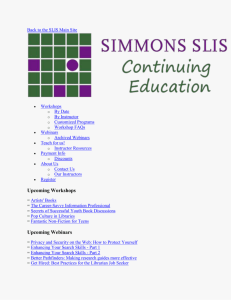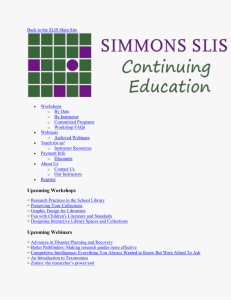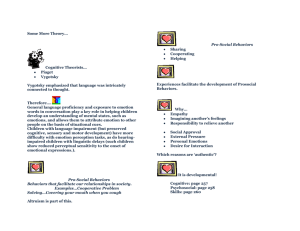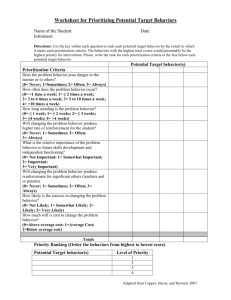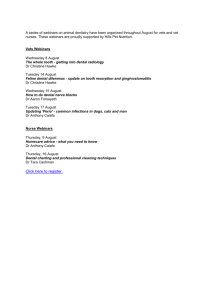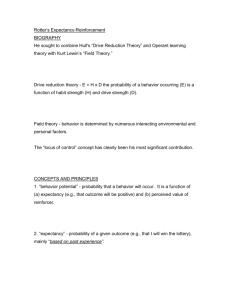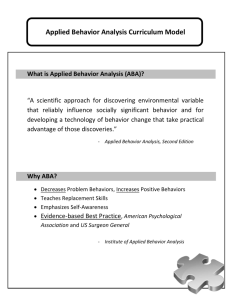Virtual Leader Facilitator Guide
advertisement
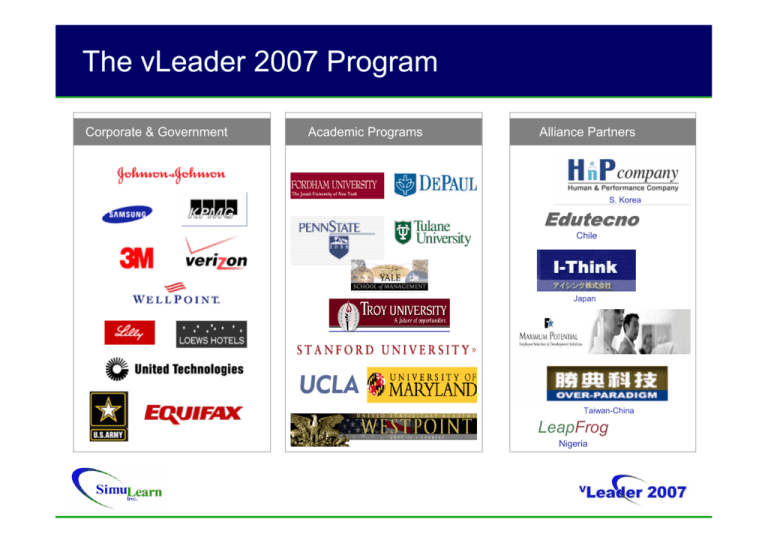
The vLeader 2007 Program Corporate & Government Academic Programs Alliance Partners S. Korea Edutecno Chile Japan Taiwan-China LeapFrog Nigeria vLeader 2007 Program • Program Overview • Results • Program Benefits • Deployment Options • Getting Started Program Overview • Practiceware; software to practice key skills • Blended Learning Program; webinars or ILT • Award Winning • Accredited by PMI Practice and Apply Skills and Styles 9 9 9 9 9 9 9 9 9 Delegative Influencing Others Conflict Management Innovation – Creativity Team Building – Collaboration for Better Results Motivation - Persuasion Work Prioritization Situational Awareness Active Listening - Effective Communication Align Decision Making with Business Goals Participative Directive vLeader 2007 Practiceware Practice Here Apply Here Learning becomes Intuitive Consciously Consciously incompetent competent 2 3 Unconsciously Unconsciously incompetent competent 1 “Intuitive” 4 Practice and Repetition to Reinforce and Build Skills Skills Properly Applied Produce Better Results Blended Learning Program Simulation Practice Feedback + + Virtual Class Self study Coaching On Demand Join a weekly webinar Results • Accelerated Learning • Measured Performance Improvement • Increased Individual and Team Productivity • Case Studies: results page @ www.simulearn.net vLeader 2007 Fortune 100 Case Study Accelerates Learning: ¾ Awareness – Communication & Leadership ¾ Ability – new skills, behavior change Accelerates Results: (think) (act) “significant & sustained” + 41% performance improvement (more effective) + 22% business results (more productive) Fortune 100 case study “Rapid, significant and sustained performance and business results” Reduction of Negative Behaviors 5.0 10.0 70.0) 65.0Superiors (41.4% 15.0 75.0 s (61.9%)80.0 Subordinate 41% Performance Improvement noted by Management 85.0 22% Increase in Business Results Self (31.7%) 20.0 Peers (43.1%) 25.0 Increase of Positive Behaviors 360 assessment - Pre-Useof Virtual Leader 360 assessment - Post-Useof Virtual Leader (Real client datafroma Fortune100 company) Increased Positive Behaviors 1. Thought Expressed – assertive; openly express ideas 2. Equality Seeking – treat others as equals 3. Leading Others – with personal influence 4. Encouraging – working toward helping others do better 5. Collaborate – persuading others towards cooperative efforts 6. Achievement Seeking –creating achievements 7. Responsive – expresses positive energy towards tasks Reduced Negative Behaviors 1. Intimidating – dictates with a superior attitude 2. Revenge Seeking – gets even; quick to retaliate 3. Critical – tries to control others by using criticism 4. Self-centered – expects favors; does not return favors 5. Detached – avoids interaction with others 6. Insensitive – acts as if they cannot relate to others 7. Action Suppressed – avoids ordinary work Emotional Intelligence Study vLeader on Emotional Intelligence vLeader significantly increased in respondent scores in three of the four subscales after the respondents participated in the simulation 63% 70% 44% 60% 50% 22% 40% 30% 7% 20% 10% 0% Self Emotion Others Emotion Regulation of Emotion Use of Emotion West Point Case Study - 2006 Change in Application of Leadership Styles 5.6 Estimated Marginal Means 6.3 5.4 Style Directive 5.2 6.2 6.0 Participative 5.0 Delegative 4.8 5.8 5.6 1 TIME 2 Online Army Case Studies 1 TIME 2 Virtual Leader The Virtual Leader group elicited more self awareness based on performance measures and survey results polling acceptance of the program. The Virtual Leader group was able to correctly choose the optimal leadership style for the situation after being made aware of their tendencies better than those in the Army Case Study group. West Point Case Study – 2006 Change in application of Leadership Styles Mean % Correct Approach 0.75 0.8 0.7 % Correct 0.6 0.5 0.4 0.25 Case Study (C) Virtual Leader (E) 0.34 0.3 0.24 0.2 Virtual Leader (E) 0.1 0 Case Study (C) Pre-Instruction Post-Instruction Verizon Wireless – Diane C. The program has improved my Listening and Communication Skills, Teambuilding, Motivating and Increased Productivity. Since using the program I’ve been working on building up morale with my team and I’ve improved my numbers this month. I’ve been giving more recognition, which is something I still struggle with, since I feel that I don’t need positive reinforcement therefore they shouldn’t need it either. United Technologies – Bridgette R. I see conversations differently now with my teams. I spend less time “beating around the bush” with my employees in discussing some issues. I am more assertive in presenting my opinion in certain situations which has been helpful and more productive. My fellow desk manager has noticed the changes too. Virtual Role Play Five Scenarios Hundreds of Outcomes Sample Feedback, Metrics and Questions Self- Assessment Questions • What style would work best with this group or individual? • What is the right work? (balanced scorecard) • Do you need to generate new ideas? • Who are the people involved? Can you form an alliance? • What are their opinions of the ideas? • Is the group aligned around the right work? • What is your level of influence? How can you improve it? • What is the group’s tension level? How can you moderate it? • What is the group’s opinion of you? How can you improve it? • How can you get their buy-in? Leadership Principles Formal Authority Power Power Ideas Group’s Opinion & Trust Personal Influence Successfully Introduce Ideas Uncover Hidden Ideas Relax Tension Tension Moderate Excite Excite Complete Complete the theRight Right Work Work Work Work Work Prevent Prevent The TheWrong Wrong Work Work Covey Blanchard Kotter Posner Maxwell Welch Benefits: Participants Managers and Teams • Reduce time to competency of key skills • Align decision making and behaviors with strategic goals • Improve ability to understand, direct and influence people and situations • Improve team performance and productivity Benefits: Organization • Instill a common language or “operating system” in individuals throughout the organization for use in everyday interactions and decision making Communication Leadership Balanced Scorecard • Personal Effectiveness • Team Building & Collaboration • Influence, Persuade, Motivate • Productivity Improvement • Unify and align departments around strategic goals • Provide a performance solution that is personal, transformative and yet scaleable for the entire company Benefits: Organizations and Schools • Easily deployed to large/dispersed audiences • Measurable - online reports for: 9 Usage 9 Completion 9 Proficiency • Provides ongoing reinforcement thru practice and repetition for sustained performance improvement Deployment - Participant Materials • Simulation software use for one year for ongoing practice and reinforcement of key skills (CD-Rom or Download) • Access to facilitated webinars for the program • Workbook, leadership materials and resources • Personalized on-demand coaching support • Access to online scores and resources • Self-assessment survey (optional) Deployment Options Corporate Programs • Structured program o 5 one hour webinars – one/week for 5 weeks o 15-20 hours of self-paced, self-study • $499/pp software and materials • $150/pp on demand coaching • $2,500 facilitation fee (up to 20pp) • Train-the-Trainer Programs available Academic Programs • $59 per student – Undergraduate and Graduate • $99 per students – Executive MBA • Train-the-Trainer for Professors $1,500 Site License – Corporations or Schools Open Enrollment “Virtual Practice Lab” • Regular weekly and monthly webinars • Join live or recorded webinars for 24/7 access • Ongoing webinars throughout the year for reinforcement Thank you Tom Parkinson Vice President, Client Services SimuLearn Inc. 301.774.4525 tom.parkinson@simulearn.net www.simulearn.net

